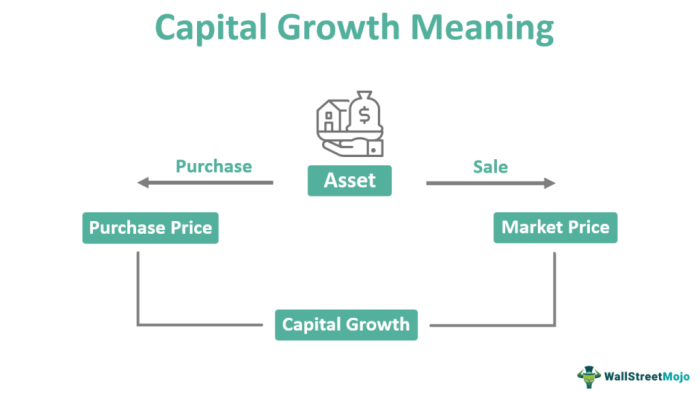
Tax Strategies for Capital Growth sets the stage for this enthralling narrative, offering readers a glimpse into a story that is rich in detail with casual formal language style and brimming with originality from the outset.
As we delve into the world of tax strategies for capital growth, we uncover key insights that can shape your financial future and help you navigate the complex landscape of investment and taxation.
Tax Strategies for Capital Growth
When it comes to maximizing capital growth, implementing effective tax strategies is crucial. By minimizing tax liabilities and optimizing investment returns, individuals can accelerate the growth of their capital over time.
Tax-Efficient Investment Vehicles
There are several tax-efficient investment vehicles that can help individuals achieve capital growth while minimizing tax implications. Some examples include:
- 401(k) and IRA accounts: These retirement accounts offer tax advantages such as tax-deferred growth or tax-free withdrawals, allowing investments to grow more efficiently.
- 529 College Savings Plans: Contributions to these plans are made with after-tax dollars, but withdrawals for qualified education expenses are tax-free, providing a tax-efficient way to save for education expenses and grow capital.
- Index funds and ETFs: These investment options tend to have lower turnover rates, resulting in fewer taxable events and potentially lower capital gains taxes for investors.
The Importance of Tax Planning
Proactive tax planning plays a vital role in maximizing capital growth potential. By strategically managing taxable income, deductions, and credits, individuals can optimize their tax situation and retain more of their investment gains. This can involve utilizing tax-efficient investment vehicles, harvesting tax losses, and taking advantage of tax-deferred or tax-free accounts to enhance overall capital growth.
Capital Allocation

Capital allocation refers to the strategic distribution of funds across different investment opportunities to maximize returns while managing risks effectively. It is a crucial aspect of investment management as it determines how resources are deployed to achieve the desired financial goals.
Different Capital Allocation Strategies
There are various approaches to capital allocation that investors can utilize based on their risk tolerance, investment horizon, and financial objectives. Some common strategies include:
- Equal Weighting: In this strategy, an equal amount of capital is allocated to each investment, regardless of the size or potential return.
- Market Capitalization Weighting: Capital is allocated based on the market value of each investment, giving more weight to larger companies.
- Strategic Asset Allocation: Investors set target allocations for different asset classes and periodically rebalance the portfolio to maintain the desired mix.
Comparison of Different Approaches to Capital Allocation
| Approach | Advantages | Disadvantages |
|---|---|---|
| Equal Weighting | Simple and easy to implement. | May lead to concentration risk in underperforming assets. |
| Market Capitalization Weighting | Reflects the market’s view of each investment’s value. | May overweight overvalued assets. |
| Strategic Asset Allocation | Allows for diversification and risk management. | Requires ongoing monitoring and rebalancing. |
Maximizing Capital Growth
When it comes to maximizing capital growth, tax optimization plays a crucial role in ensuring that your investments yield the highest returns possible. By strategically managing your taxes, you can minimize the amount of money you owe to the government, leaving more capital available for growth.
The Role of Diversification
Diversification is a key strategy for maximizing capital growth as it helps spread risk across different asset classes. By investing in a variety of assets such as stocks, bonds, real estate, and commodities, you can reduce the impact of market fluctuations on your overall portfolio. This can lead to more stable and consistent growth over time.
The Impact of Risk Management
Effective risk management is essential for capital growth as it helps protect your investments from potential losses. By implementing strategies such as setting stop-loss orders, using hedging techniques, and conducting thorough research before making investment decisions, you can minimize the impact of market volatility on your portfolio. This can help ensure steady and sustainable growth in the long run.
Long-Term vs. Short-Term Capital Growth

When it comes to capital growth, investors often have to decide between pursuing long-term or short-term objectives. Each approach has its own benefits and risks, especially when considering the impact of tax strategies.Long-term capital growth focuses on building wealth over an extended period, typically five years or more. Investors with this objective are willing to withstand market fluctuations and are more interested in the overall growth of their investment portfolio.
Tax strategies for long-term capital growth often involve taking advantage of tax-deferred accounts like IRAs or 401(k)s, as well as capital gains tax rates that are lower for assets held longer than one year.On the other hand, short-term capital growth aims to generate quick profits within a shorter time frame, usually less than a year. Investors pursuing short-term gains may engage in more active trading or speculation, which can lead to higher tax liabilities due to short-term capital gains being taxed at ordinary income tax rates.
Additionally, the risks associated with short-term capital growth include market volatility, timing issues, and higher transaction costs.
Effects of Tax Strategies on Long-Term Capital Growth
Tax-efficient investing is crucial for long-term capital growth as it helps investors maximize their after-tax returns. By utilizing strategies like tax-loss harvesting, diversification, and asset location, investors can reduce their tax burden and keep more of their investment gains. This allows for compounded growth over time, as taxes are minimized, and more capital is available for reinvestment.
Risks Associated with Focusing on Short-Term Capital Growth
Focusing on short-term capital growth comes with its own set of risks, primarily due to the volatile nature of short-term investments. Market timing, unexpected events, and emotional decision-making can all lead to losses in the short term. Additionally, the higher tax implications of short-term gains can eat into profits and hinder overall portfolio growth. It’s essential for investors to carefully weigh the risks and rewards of short-term strategies and consider the long-term impact on their financial goals.
In conclusion, Tax Strategies for Capital Growth illuminates the path towards financial prosperity through savvy tax planning and strategic investment decisions. By implementing these insights, you can unlock the full potential of your capital growth journey and achieve your wealth-building goals with confidence.
Common Queries
What are the key benefits of tax-efficient investment vehicles for capital growth?
Tax-efficient investment vehicles can help minimize tax liabilities, allowing for greater capital accumulation over time.
How does risk management impact capital growth strategies?
Effective risk management can safeguard your capital growth by mitigating potential losses and ensuring a more stable investment portfolio.





